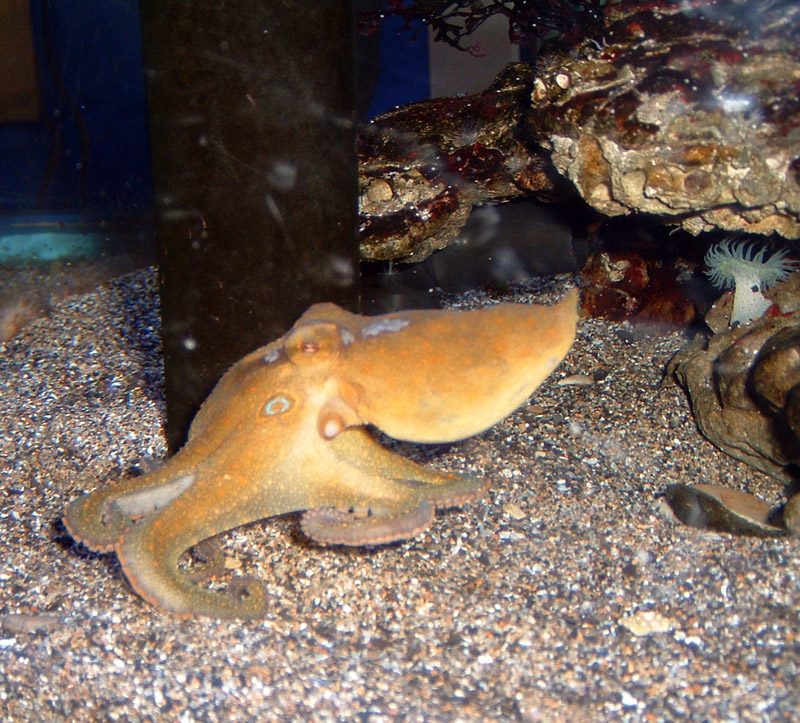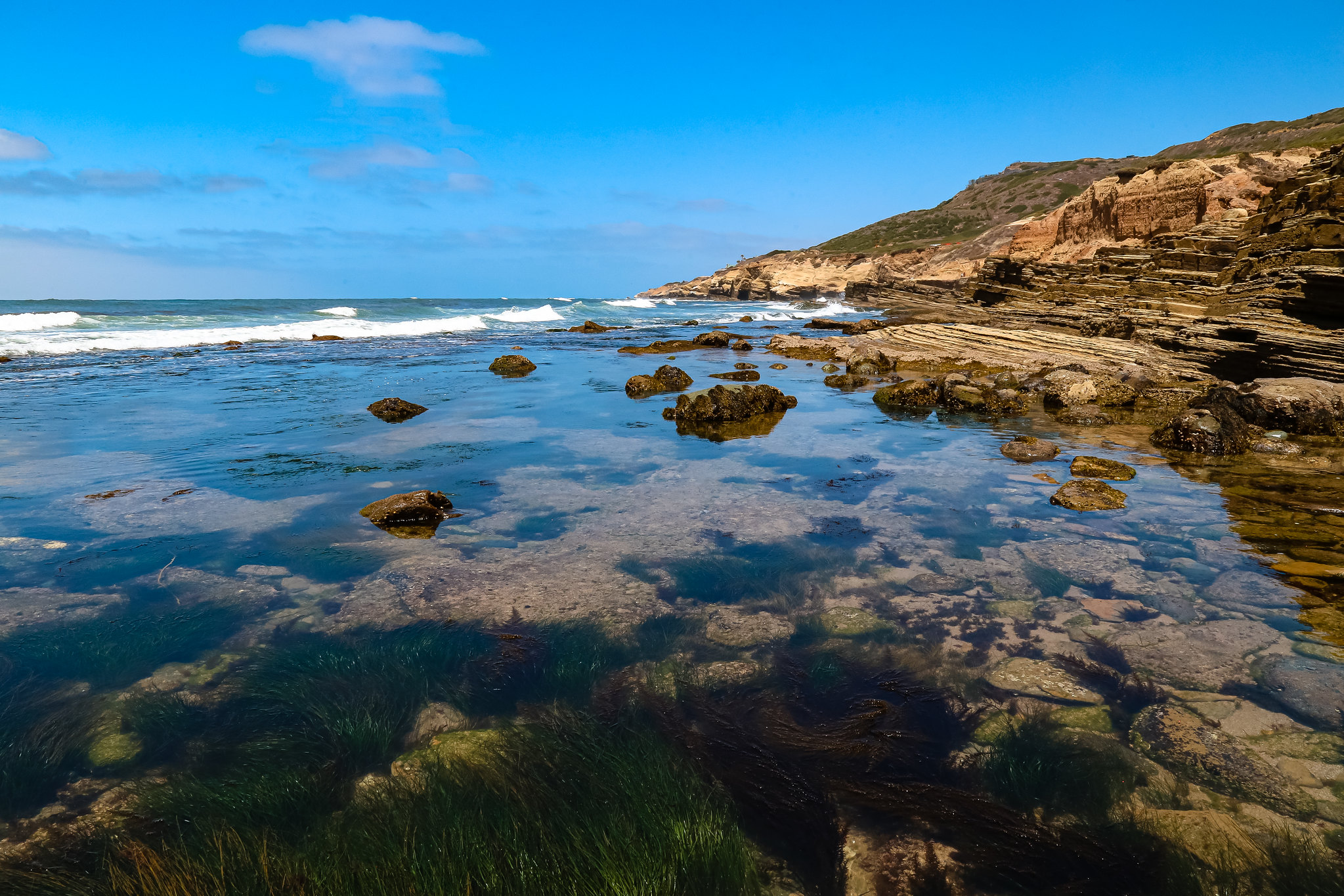In many aspects, the California Two-spot Octopus has a unique appearance and characteristics. Its scientific name, Octopus bimaculoides, means “two-spotted”, which is why the common name is California Two-spot Octopus, a reference to the iridescent blue circles, known as ocelli, on both sides of its head. Like its octopod counterparts, it is a soft-bodied mollusk with eight tentacles, but can be distinguished by its two, bright blue spots on its body. This is an adaptation to scare away predators, with their blue spots seemingly looking like eyes. The two spots are very large, which makes a predator think that the octopus is much larger than it is. Additionally, they can change the texture and color of their skin when hunting, mating, or responding to external stimuli. They can do this since they have thousands of cells called chromatophores, with each of these cells containing tiny sacs that can be filled with red, orange, yellow, or black pigment. They use these pigments by squeezing these sacs, allowing them to change their colors quickly. Using these adaptations, they can evade predators by camouflaging with their surroundings, allowing them to live up to 1.5-2 years. After mating, the eggs of the octopus mature quickly at the embryonic stage, with young emerging from the egg that is fully capable of hunting and feeding themselves. Although they have a short life span, they make up for it by producing many offspring very quickly, keeping their population strong.

Photo courtesy of J. Selan Santa Monica Pier Aquarium - A California Two-Spot Octopus crawls on the sand in an aquarium.
Like many other animals, the two-spot octopus plays a crucial role in their ecosystem; they serve as both prey and predator, fitting into the ecosystem like pieces in a puzzle. Their main diet consists of limpets, Black Abalone, snails, clams, hermit crabs, and small fishes; marine creatures that are within the intertidal area. This balances the population of these animals, allowing for a more stable ecosystem. But like many other animals, they also play the role of prey. The predators of the two-spot octopus include adult Moray Eels, who usually attack them and rip off their arms, Scorpionfish, and humans. Being a part of the food chain, they provide a food source for these predators, helping to sustain their population.
As the Anthropocene (human era) continues, the human impact on the earth has affected many animals, like the two-spot octopus. A human impact that has affected the two-spot octopus is water quality or ocean water becoming polluted from human activity. The two-spot octopus is a species whose population fluctuates in good or bad water quality, and their immune system can be impaired if the water quality is bad. Other species are also sensitive to water quality, and poor water quality can lead to decreased animal populations and harsh competition between species. If there was a major decrease in crustaceans and fish, the two-spot octopus would drastically decrease due to scarce food. And other species such as the Moray Eels’ population would all reduce. This is a chain reaction of an ecosystem diminishing, meaning we need to help deal with this problem. One way we can help this species is to avoid interrupting wildlife altogether. Even one action from interrupting wildlife can affect the overall ecosystem, as it would be one less creature to reproduce and become food for other animals. Thus, avoiding wildlife areas can prevent the two-spot octopus’s extinction.
Another thing we can do as a community is to reduce our carbon footprint. Reducing our carbon footprint can allow us to help mitigate climate change, and to pause climate change’s effect on wildlife. Ocean acidification is a byproduct of climate change, and it can affect octopuses' metabolic rate or rate of energy use. We aren’t yet sure how this impacts the two-spot octopus, as scientists are still deducing this matter, but what we are sure of is that the environment is our responsibility because we are the ones who are destroying it. Ways to reduce your carbon footprint are to reduce the amount of time you have your lights on, reuse and recycle, support clean energy sources, and lastly strive for bikes as transportation instead of automobiles. Everyone has a distinct voice, so utilizing its powerful echo can save the two-spot octopus, an important member of the ecosystem. Saving this animal will ultimately be an asset in keeping the environment healthy, and helping to mitigate mass extinction. Your actions matter and can help preserve and protect important species like the California Two-spot Octopus.

NPS/C. Aurrecoechea - A view of Cabrillo National Monument’s Rocky Intertidal Zone (tidepools) on a calm day.
Sources:
“California Two-Spot Octopus.” Marine Biological Laboratory, www.mbl.edu/research/research-organisms/california-two-spot-octopus#:~:text=California%20two%2Dspot%20octopuses%20(Octopus,ocelli%2C%20on%20both%20their%20sides. Accessed 15 Nov. 2023.
“How Does an Octopus Change Its Colour and Shape?” Two Oceans Aquarium, www.aquarium.co.za/news/how-does-an-octopus-change-its-colour-and-shape#:~:text=Just%20beneath%20their%20skin%2C%20octopuses,of%20each%20of%20these%20colours. https://royalsocietypublishing.org/doi/10.1098/rstb.1996.0090. Accessed 15 Nov. 2023.
“Two-Spot Octopus.” Cabrillo Marine Aquarium, www.cabrillomarineaquarium.org/exhibits/socal-species-details.asp?id=19#:~:text=The%20two%2Dspot%20octopus%2C%20which,%2C%20crustaceans%2C%20and%20occasionally%20fish. Accessed 15 Nov. 2023.
UCSD Students. “California Two-Spot Octopus.” California Sea Grant,caseagrant.ucsd.edu/seafood-profiles/california-two-spot-octopus. Accessed 24 Oct. 2023.
“CALIFORNIA TWO-SPOT OCTOPUS.” Montereybayaquarium.Org, www.montereybayaquarium.org/animals/animals-a-to-z/two-spot-octopus. Accessed 24 Oct. 2023.
“California Two-Spot Octopus.” Marine Biological Laboratory, www.mbl.edu/research/research-organisms/california-two-spot-octopus#:~:text=California%20two%2Dspot%20octopuses%20(Octopus,ocelli%2C%20on%20both%20their%20sides. Accessed 15 Nov. 2023.
